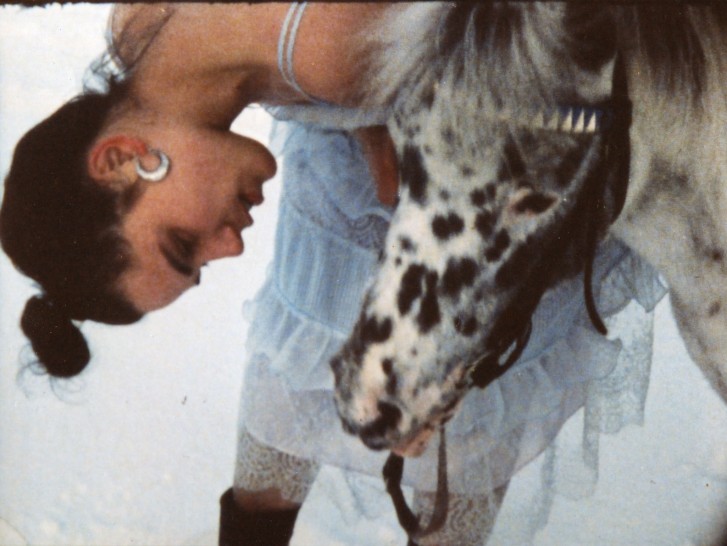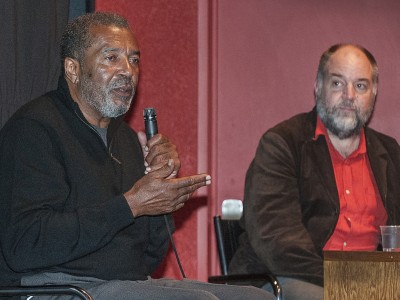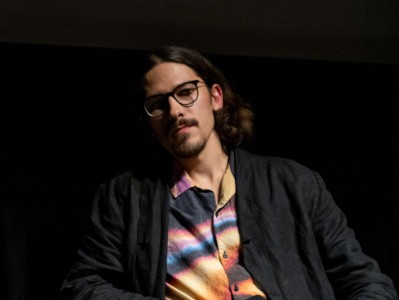
Film Diaries and Other Ways of Seeing introductions and post-screening discussion with Haden Guest, Ute Aurand, Milena Gierke and Renate Sami. [Some of audio missing]
Transcript
HADEN GUEST 0:00
Good evening ladies and gentlemen, welcome to the Harvard Film Archive. My name is Haden Guest, I’m HFA Director. I want to thank you for coming to this special program that brings us not one, not two, but three special visitors--three artists, filmmakers from Berlin—they're all based in Berlin—each working in quite distinctive traditions and approaches to film form. But in this program we're going to see, we've selected a body of work which is loosely united by the diaristic mode in which we find them working. The three filmmakers, of course, are Ute Aurand, Milena Gierke, and Renate Sami, who are here tonight. This is a program that we've been wanting to do for a while; we've been working together with Karen Beckman, who was the real impetus who made this program possible. So I want to thank Karen. She comes from the University of Pennsylvania, and she's working on a book called Making Spaces: German Experimental Women Filmmakers.
[APPLAUSE]
It's also a special evening because we're going to be projecting Super 8. And this is the work of Milena Gierke, which we're going to be seeing in the second half of the program. We're going to be taking a ten-minute or five-minute intermission after Film Diary, the second work in the program, just to set things up. I want to thank Saul Levine of Mass Art for lending us this wonderful projector. And I want to thank Liz Coffey, HFA film conservator, who's going to be projecting. And now, all of the filmmakers are going to be introducing their work, and so we'll be bringing up the house lights and welcoming each of the respective artists to say a few words. At the conclusion of the program, they will all join us up at the front of the theater, and we'll have a discussion about the work that you've seen. So now please join me in welcoming Ute Aurand.
[APPLAUSE]
UTE AURAND 2:19
Yes, thanks a lot that we can be here tonight. You will see two works of mine, this one, which we are starting the program, the name is OH! Die 4 Jahreszeiten (OH! The 4 Seasons). And it's a collaboration between myself and my filmmaker friend Ulrike Pfeiffer, with whom I was studying together at the film school in Berlin. And this film is the first film we did after leaving the film school. And actually, these four seasons are connected to four cities, and you will see the first winter section filmed in Berlin. And when we started the film, we didn't have a real concept that we would make these four seasons, we were very much inspired, of the winter during the film festival in Berlin. In February, the city was full of snow. We have seen a Jonas Mekas film, and we thought, let's take the camera and film. So we planned, we had only two little reels, we filmed with a Bolex, a silent 16-millimeter camera, and did this film, and chose the music, the music which you will hear before. And then we were inspired by our own work, because we have never worked like this before. So when we put the sound and image together, there was some synchronicity and kind of working and fitting very well. So then we thought, let's go on, and then we created the idea of going through the four seasons, and associated the seasons with cities. So we chose the summer in Paris. This was the next that we were filming, and then spring—we thought, where to go in spring?—the revolution, we go to Moscow. And in the end we went to London. This was the last film, also, what we have shown, so you see it in the order, and I think you will see us 20 years younger [LAUGHS].
[APPLAUSE]
RENATE SAMI 4:34
Thank you, Karen, thank you Haden. I'm going to make it short. The next film we are going to see is called Film Diary, from ‘75 to ’85, and it was originally done on Super 8, and it was transposed to mini-DV. Contrary to my colleagues, I work with many formats, and these Super 8 films, were made on the side, in the beginning. I made some other films and 16-millimeter feature film, and the long documentary—long films, some short films, I was preparing a film on Cesare Pavese, and beside, all this time, I did these Super 8 films to try out things. Also to film family, friends, even atmosphere. Of all these many films, I thought it would really fit together to give an impression of—well, one aspect of Berlin at that time. So, it's 30 minutes, and have a good time.
[APPLAUSE]
MILENA GIERKE 6:00
Hello. So, we just continue with Super 8 now. I'm Milena Gierke. And thank you very much Haden and Karen, for coming, for letting us coming here, and getting the Super 8 projector, which is really great. I'm very happy also to have a possibility to show the film here in a Le Corbusier cinema, because I'm very attached to him, and I did already a film about his house in Marseille. But, I don't show you this film now. It's a little bit sad—afterwards, I realized that. But I have this film on 35 millimeter now, so maybe, that’s…. Actually, I'm specialized on Super 8 since I started in 1990, and all of my films are edited in the camera, which means that there's no editing after the development process, which is a very important point in my work. They are mostly all without sound. And… what else shall I say? Oh yeah, this one is Stilled Life. And at that point, it's like a diary film, how Haden mentioned already a little bit. I'm in the south of France, I was sick at that time and I could stay at my uncle's house for one month. He's a doctor, so that was good to be there. And I was like, this one month, all the time around this house. I wasn't [going anywhere] else. So it's a little bit about my mood in this, and like, my visual diary in this time. All right, and afterwards... [INAUDIBLE].
[APPLAUSE]
RENATE SAMI 8:44
Okay, the next film you're going to see is called The Protection Foil. It's a 16-millimeter, and I did it in 1983. Since there has been nuclear energy, you know that these plants sometimes leak, or explode, and people get burned, and cancer, and at that time, there was a movement against it. And some women decided to make a film. And they asked me to do something. And I thought, well, the government proposed as a protection to buy this foil, and to wrap oneself into it, and well, hide under a table or something. And I bought such a foil, and found it very beautiful in the light, and played around with it. And at the same time, I heard an American singer, a young girl, she had a very beautiful voice. She was moving around, bars, and places, and at birthdays she sang, and I put these two things together. And this is the film. It's about seven minutes. One long shot.
[APPLAUSE]
UTE AURAND 10:17
The last three films of this program tonight, are the most recent work I have done and just finished in the summer--three short, silent films. One can see them also as individual pieces, but here, I thought I would show them as a triptych. So you see, there will be black in between, and the first one is A Walk, four minutes long; and then Im Park, six minutes long; and then Zuoz, which is the name of a village in Switzerland, one and a half minutes long.
[APPLAUSE]
HADEN GUEST 11:16
Well, thank you, my special thanks to all three of you for coming here and for sharing your work with us. It was a wonderful show. So I thought I'd start with, maybe, a couple questions just to get the ball rolling, so as to speak. Starting with the most recent work, then, Ute, I’m wondering if you can tell us... These are very lovely films, and you spoke of them as a triptych. And I'm wondering if you could talk a little bit more about what unites them, and what interests drew you to create these films. And one unitary aspect of the films is certainly this interest in classical art and its juxtapositioning with nature. So, I'm wondering if that's [INAUDIBLE]
UTE AURAND 12:08
[LAUGHS] Yeah, but this is maybe, one can find in... This is always in my work, sometimes it appears, you know? So for me, I come back actually, to my very first film, back in the beginning of the 80s. Because in the last time I was more editing in the camera. This is also edited in the camera, but I wanted to go back to montage in a way—going back to the editing table and really placing things in the order like the classical montage. Especially in the Park film where it is very obvious between the black-and-white and the color. And so, one can say the new step, that I allowed myself to go back to the real editing. When I'm filming, I still make little units, which are edited in the camera mostly. ...But what you said is—yeah? [LAUGHS A LITTLE] [INAUDIBLE]
HADEN GUEST 13:18
[LAUGHS]…..OK, be democratic and ask all of you…but Renate, I'm wondering about how you brought, constructed this diary and how you decided what to bring in, what to leave out, and what sort of decision-making went into the final film that we just saw.
RENATE SAMI 13:42
Well, this film took quite a long time. At first I thought about it very long. I have lots of material. I did many of deserted stations when the wall came up, and some stations in Berlin were deserted. And I did many more friends of mine, of course, and I did– Well, the last decision—why you take this, and you don't take that—is really obscure. It's a secret, I don't know. You start with something. And then you put the next thing, and then the next, and then you take this out and put it in front, and well, it's a constant…moving the thing around in your head, going to bed with it, waking up, then you change it again. And I can't really tell you,I have now four versions of this one, and this is the last one.
HADEN GUEST 14:51
And Milena, you know, it's becoming increasingly less common to see Super 8, nowadays—and see it projected—and it was a real joy to see it tonight. I'm wondering if you could just tell us a little bit about your views on Super 8 in general, I think you're one of the more articulate artists in talking about this specific format, the small gauge. And especially your views towards what makes, what is specifically Super 8, as opposed to other gauges.
MILENA GIERKE 15:33
Yeah, well, I studied at an art school, in a class for experimental film by Peter Kubelka who was—or who is—specialized in editing. And I started with Super 8, and somehow fell so much in love with it that I thought... I mean, I tried 16, and I was editing too, because I just wanted to try it. And I realized that I felt really comfortable with the Super 8 first. I mean, of course, I saw Jonas Mekas’ Diaries. And so that was very important. But of course, also, all the American cinema has influenced me a lot. But because I studied at an art school, and not at a film school, I would even say I'm even more influenced by painting. And I also paint myself, but actually after the film studies. And one decision to study film for me was that I'm very interested and open [to] all kinds of different kinds of art.
And I just had this idea... Well, with film I’m open to mix everything because you have sound, you have colors, you have movement, you can compose, and whatever. So I felt more free. And then actually, with Super 8, I realized that I'm getting more and more pure. And I felt comfortable with that, because you can take– I mean, the good point with this camera, what you were asking was like, at the point where I started, video was not so much common already, and it was like the possibility of taking a camera with you everywhere, which is like a really important part of my work. And also that the camera itself doesn't influence the situation so much, as [it gets] bigger, it's more difficult with tripod or whatever, with more people. And now, of course, you can do that with video too. But with Super 8, you still have the possibility of being in real film. So this is like one part, then the other part is that the mechanical side of it is very important for me, because as I edit in the camera, when I push the button, and it's filming, and when I stop it, it's stopping, and this is really important, because I see myself also really as a composer in that moment, and I need to be really on time, and it's been seconds, you know? And so I cannot just put on, and wait, and then... It's really like a composer or musician or something.
This editing in the camera became really, a really meaningful thing for me. In the beginning... I didn't realize it myself, but afterwards when I started to work in different media, I realized I come back to this thing [of] being totally into the soul of one media, and with Super 8, it's this great possibility of being in this chronological way, where I had the feeling it's a metaphor for life itself, where you cannot just go back one day. It forces me to be so [concentrated on] the moment, to take life so serious, in a way, but of course like... how it is. So that it's like, not playing around—I mean, of course with joy—but you understand [INAUDIBLE] Aand I respect editing, very much, and video and all other kinds of film materials, of course. It's just that I think with Super 8, it's the soul of Super 8.
HADEN GUEST 20:10
Maybe we'll open up for some questions from the audience. Any questions or comments? Dominique?
[THIS SECTION INAUDIBLE EXCEPT FOR OCCASIONAL COMMENTS AND LAUGHTER]
[END OF INAUDIBLE SECTION] 24:26
HADEN GUEST 24:29
I mean, I feel like the first film, though, is I think the most– I would say it’s the only film that's explicitly feminist, of the ones we've seen here. No?
[INAUDIBLE COMMENT]
I would say feminist, perhaps, as for for the first one with the three, the four women spinning, sort of making the city their own.
[INAUDIBLE]
HADEN GUEST 25:00
Right.
[INAUDIBLE SECTION FOLLOWS]
[END OF INAUDIBLE SECTION]
MILENA GIERKE 25:56
Well, I think it's a pretty difficult subject, because it always depends on what you see before and after, and I mean, now we have three women here. And we’re coming from New York, and I just showed one film. In total I made about, I don't know, 65 films or something, you know. And if you would see other films of mine, maybe it would be different. But on another side, I would say "Yeah, why not? Why don't I have a feminine view because of course, I'm a woman?" But on the other side, for example, I'm very influenced by the painters, which are men, or very often men artists, for example, like Marcel Proust—I have the feeling that even him, in this way, is also feminism in a way? But I would prefer, maybe... I don't know, I don't like that so much. [LAUGHS] Because I feel myself sometimes also masculine? Do you say that? Then I also show that, in my films and I don't want to be in this… [UNKNOWN] box, yeah. [LAUGHS]
But on the other side, I like to be a woman, and to film as a woman, you know? It's just like, I mean, I want to be an artist, and artists have to be free-minded, you know?
Unknown Speaker 27:52
[INAUDIBLE].
HADEN GUEST 28:05
Other questions, comments?
[MOSTLY INAUDIBLE SECTION FOLLOWS]
[END OF INDAUDIBLE SECTION]
HADEN GUEST 29:11
Anything else? No?
HADEN GUEST 29:14
All right, well, please join me in thanking our three filmmakers.
[APPLAUSE]
HADEN GUEST 29:30
And you know, actually, there's gonna be a special treat for those of you who want to stay around. We're going to be looking at a Bruce Conner film called Television Assassination. So it will be like a preview for the complete retrospective that we'll be doing in two weeks. So you're welcome to stay or not. It's 14 minutes long.
©Harvard Film Archive
Related film series

Film Diaries and Other Ways of Seeing
Recent Work by Ute Aurand, Milena Gierke and Renate Sami
Explore more conversations
Elaine May

Billy Woodberry

Nace Zavrl

Alexander Zahlten
